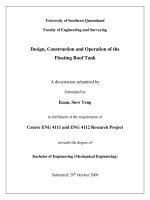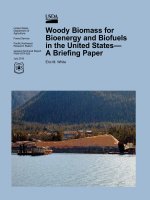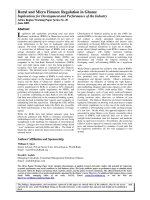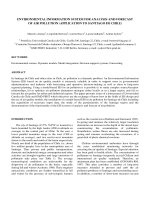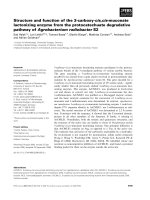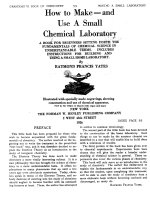TCVN 8863 2011 specification for construction and acceptance of the surface treatments using the asphalt cement
Bạn đang xem bản rút gọn của tài liệu. Xem và tải ngay bản đầy đủ của tài liệu tại đây (154.17 KB, 19 trang )
TCVN
NATIONAL STANDARD
TCVN 8863 : 2011
First Edition
Specification For Construction And Acceptance Of The
Surface Treatments Using The Asphalt Cement
HANOI 2011
TCVN 8863 : 2011
Table of Content
1 Scope of application.............................................................................................................................5
2..............................................................................................................................................................Ref
erences..................................................................................................................................................6
3..............................................................................................................................................................Ter
minology and Definition.........................................................................................................................6
4...............................................................................................................................................................R
equirements on materials of the surface treatments using the asphalt cement..............................7
5 Quantifying amount of chip and bitumen for the surface treatments using the asphalt cement on
types of pavement....................................................................................................................................8
6...............................................................................................................................................................Pr
eparation before the surface treatment................................................................................................9
7...........................................................................................................................................................Con
struction...............................................................................................................................................11
8............................................................................................................................................................Sup
ervision, inspection and acceptance..................................................................................................14
9.............................................................................................................................................................Lab
or safety and environment protection.................................................................................................17
1
TCVN 8863 :
2011
Foreword
TCVN 8863 : 2011 is converted from 22 TCN 16-79 according to
regulations in Clause 1, Article 69, Law on Technical Standards and
Regulations and point a, section 1, clause 1, Article 7, Decree
No.127/2007/ND-CP dated 01/08/2008 by the Government providing
details for implementation of some articles under Law on Technical
Standards and Regulations.
TCVN 8863 : 2011 is composed by Institute of Transport Science
and Technology, recommended by Ministry of Transport, verified by
Directorate for Standards, Metrology and Quality and published by
Ministry of Science and Technology.
TCVN 8863 :
2011
TCVN 8863 :
2011
NATIONAL STANDARD
TCVN 8863 : 2011
Specification For Construction And Acceptance Of The Surface
Treatments Using The Asphalt Cement
1
Scope of application
This standard is applied to construction and acceptance of the surface treatments using the
asphalt cement on newly constructed pavement or existing one in need of repair and recovery.
This standard is in no way applied to expressway, roads with designed velocity of 80 km/h or more.
1.1
Other layers of pavement structure are constructed in compliance with applicable relevant standards.
The surface treatments on kinds of pavement are not taken into account in calculating
the pavement strength.
1.2
The surface treatments are classified into single, double and triple bituminous types. Choosing
type is determined by the design consultant. Please refer to Table 1 for guidance of usage.
1.3
Table 1 – Usage of the surface treatments using the asphalt cement
Type of surface
treatments
1. Single
bituminous
Usage
- When the existing surface treatment is much worn out or damaged.
- When the existing surface treatment is worn out or slippery but traffic volume is
not high.
2. Double
bituminous
- When it is necessary to increase roughness, to recover flatness for various kinds
of pavement;
- When it is essential to protect and improve operational quality of crushed stone,
base pavement with or without cement consolidation with other inorganic binder
materials.
3 Triple
bituminous
- When it is needful to protect and intensify operational quality of base pavement
with traffic volume over 80 vehicles/day night (converted into vehicle of 10T axle)
while it is impossible to construct asphalt pavement (asphalt concrete, penetration
macadam...) above.
2
es
TCVN 8863 :
2011
Referenc
The following references are very necessary for applying this standard. For references with year of
publish indicated, apply the stated version. For those specifying no date of issuance, apply the
latest version including modifications and supplementation (if any).
TCVN 7493:2005
Bitumen – Technical specifications
TCVN 7504:2005
Bitumen –Test method for determination of adhesion with paving stone
TCVN 7572-8:2006
Method for determination of content of dust, mud and clay and
content of clay lump
TCVN 7572-11:2006
Test method for determination of crushing value of coarse aggregates
TCVN 7572-12:2006
Test method for determination of abrasion and impact in the Los
Angeles machine
TCVN 7572-13:2006
Test method for determination of elongation and flakiness content
TCVN 7572-17:2006
Test method for determination of feeble weathered particle content
TCVN 7572-18:2006
Determination of crushed particle content
TCVN 8859 :2011
Crushed stone base in highway structure – Material, construction and
acceptance
3
Terminology and
Definition
Single Bituminous Surface Treatment – or simply called Single Surface Treatment,
abbreviated as SST; or Chip Seal), is constructed by application of one layer of bitumen and chip
then compacted.
3.1
Double Bituminous Surface Treatment – or Double Surface Treatment, abbreviated DST
is constructed by repetion of Article 3.1 process in twice.
3.2
Triple Bituminous Surface Treatment – or Triple Surface Treatment, abbreviated TST), is
constructed by repetion of Article 3.1 process in three times.
3.3
Bituminous Material For Prime Coat is used to evenly spray on the base course surface
with mineral material using no organic binder material, with the purpose that a part of bituminous
material will absorp into the base surface of 5 to 10mm thickness as prime coat, and a part of it
will be adhesive to stone material on which bitumen will be applied.
3.4
Bituminous Material For Tack Coat is employed to spray evenly on the surface of the
mineral material layer using organic binder material or on existing pavement, so that it creates
adhesion with stone layer on which bitumen will be applied.
3.5
2
2
Cutback asphalt has average hardening speed and viscosity of 30 mm /s to 60 mm /s, coded
3.6
2
2
as MC30. Cutback asphalt with average hardening speed and viscosity of 70 mm /s to 140 mm /s at
O
60 C is coded as MC70.
1
Fine
aggregate:
Refers
to the
mixture
of sand
aggregates
with
size ranging
from sand.
0.14mm to 5mm.
Fine aggregate
may
be natural
sand,
crushed
or mixture
of natural
and crushed
International Roughness Index, or IRI refers to the index indicating the flatness/smoothness of
pavement, measured in m/km. The smaller this value is, the flatter the pavement is .
Measurement of IRI can be by dedicated devices such as TRL Profile Beam; Laser Profile
Systems; Road Master IRI – Tester and GPS; Bump Integrater...
3.7
4 Requirements on material of the surface
treatments using the asphalt cement
4.1
Stone
Stone or chip used in the surface treatments must be crushed from rubble stone or mountainous
stone. We may use gravel containing more than 85% particle volume on 4.75mm sieve having at lest
two surfaces of fraction and no more than 10% of volume is silicate based gravel.
4.1.1
4.1.2
Do not use stone crushed from Marl stone, clay sandstone, clay
shale.
Physico – mechanical properties of chip crushed from above original stone shall satisfy
specifications in Table 2.
4.1.3
Table 2 – Physico – mechanical properties for chip used in the surface treatments
using the asphalt cement
Properties
1. Crushing value of broken gravel, %
Level
8
2. Los Angeles Abrasion, %
a) For rock and metamorphic stone
b) For sedimentary rock
3. Content of broken gravel (at lest 2 surfaces of
fraction) in volume of gravel retained on sieve 4.75mm,
%
Test method
TCVN 7572-11: 2006
TCVN 7572-12: 2006
25 (30)
35 (40)
85
4. Elongation and flakiness content (particle on sieve
4.75mm),%
15
TCVN 7572-18: 2006
TCVN 7572-13: 2005
5. Feeble weathered particle content, %
5
TCVN 7572-17: 2006
6. General content of dust, mud and clay, %
1
TCVN 7572-8: 2006
7. Content of clay lumps, %
0,25
TCVN 7572-8: 2006
8. Adhesion of paving stone with bitumen
Pass
TCVN 7504: 2005
NOTE: Value in blanket () is only used for roads with designed velocity Vtk < 60km/h
4.1.4
Size of chips used in the surface treatments using the asphalt cement are is stated in Table
3. Each size of chip is symbolized as dmin/Dmax, where dmin is the nominal minimum size and Dmax is
the nominal maximum size (by square sieve). Depending on single, double or triple treatment we
choose the size as appropriate as in Section 5.
Table 3 – Sizes of chip (by square sieve) used in the surface treatments using the asphalt
cement
dmin
Dmax
nominal, mm
nominal, mm
Size 12.5/19
12.5
19
Size 9.5/12,5
9.5
12.5
Size 4.75/9.5
4.75
9.5
Size of chip, mm
NOTE: The amount of particle with size larger than nominal Dmax shall not exceed 15% volume.
The amount of particle with size smaller than than nominal Dmin shall not exceed 10% volume.
4.1.5
4.2
men
Chip must by dry and clean.
Bitu
4.2.1 Bitumen used in the surface treatment using the asphalt cement must be oil based with
penetration of 60/70 to be heated to 160oC when paving. Depending on weather condition and type of
chip, the Design Consultant may allow using bitumen 40/50 (or 85/100 with suitable temperature).
Above bitumen shall meet technical specifications in TCVN 7493-2005 Bitumen – Technical
specifications.
4.2.2 Bituminous material for prime coat must be cutback asphalt or emulsion with average hardening
speed of MC70 or MC30.
4.2.3 The bitumen must be clean without water and impurities.
4.2.4 Before using bitumen, check documents of technical parameters of the bitumen and test the
same as required by TCVN 7493-2005.
5 Quantifying amount of chip and bitumen for the surface treatments using the
asphalt cement on types of pavement.
5.1 Amount of chip and bitumen depends on type of the surface treatments and paving sequence
as stated in Table 4.
Table 4 – Quantifying amount of chip and bitumen used in single, double and triple surface
treatment.
Bitumen
Chip
Surface
treatment
Thick
ness
Double
Surface
treatment
1,0
Once only
1,2 *
Once only
1,5
Once only
1,5 (1,8)
Once only
9,5/12,5
15-17
9,5/12,5
14-16
2,0- 2,5
Thick
ness
(cm)
Sequence of
application
First time
Sequence of
application
First time
NOTE:
3.0- 3.5
2
(kg/m )
1,5 (1,8)
Sequence
of paving
First time
Bitumen
Second time
Triple
Chip
amount
Stone
size
(mm)
4,75/9,5
(cm)
Single
Bitumen
amount
2
(L/m )
10-12
Chip
Bitumen
amount
(kg/m )
Sequence
of paving
1.2
Second time
2
1.7 (1.9)
First time
Stone
size
(mm)
4.75/9.75
Chip
amount
2
(L/m )
10-12
12.5/19
18-20
Second time
1.5
Second time
9.5/12.5
14-16
Third time
1.1
Third time
4.75/9.5
9-11
1 – (*) Only used for single surface treatment on existing pavement of little traffic volume
2 – Value in the ( ) refers to the amount of bitumen applied for the first time when treating with the
asphalt cement on newly constructed crushed stone pavement.
3 –When constructing manually, it is permitted to increase bitumen amount by 5%.
4 – Rate of bitumen in table 4 above excludes prime coat.
5.2 To make the material volume accurate and to check operation of machine as well as the
combination of stages of bitumen spreading, chip paving, compaction, before mass scaled construction,
it is advisable to conduct trial construction with one section of at least 100m and adjust appropriate to
actual condition.
6 Preparation before the surface treatment
6.1 Depending on the type of pavement to be treated using the asphalt cement, whether it is new or
existing crushed stone pavement, stone aggregates pavement, crushed stone pavement or cement
consolidated stone aggregates, soil pavement consolidated with cement or lime, newly constructed or
existing pavement (asphalt concrete, penetration macadam, the surface treatment and so on), the
preparation of surface treatment may be different.
Before treatment, the pavement structure shall satisfy requirements in terms of strength and geometric
factor as designed. If it is existing one, it must be repaired to resume the shape, cross section and
flatness.
The surface treatment for pavement shall be conducted only in sunny and dry weather, with
temperature no more than 15oC. Otherwise, it is preferable to apply method of the surface treatment
with acid based emulsified asphalt.
6.1.1
Prepare surface for crushed stone base course.
6.1.1.1 Before treating, the surface of crushed stone base course must be cleaned, dried and leveled,
with cross slope as in design.
TCVN 8863 :
2011
If it is crushed stone base newly constructed, it shall be accepted following requirements in the TCVN
8859:2011 - Crushed stone base in highway structure – Material, construction and acceptance.
If it is existing base course, repair of leveling, filling of pothole and depression shall be completed at
least 2 days before.
6.1.1.2 To sweep, clean, blow (with compressed air) the crushed stone base course. Be careful when
using cleaning truck to prevent pulling out of aggregates on the upper side of pavement. If the
pavement is dirty, muddy, flush water to clean it and wait until the pavement becomes dry, then apply
the prime coat. The scope of pavement cleaning is 0.20m larger than scope of bitumen application
along two edges.
6.1.1.3 On the clean and dry crushed stone base surface, apply an amount of prime coat following
section 4.2.2 with standard of 1.0 kg/m2 to 1.3 kg/m2. This amount of prime coat is quite enough to
penetrate deeply into crushed stone base layer of 5mm to 10mm thickness and enclose remaining dust
particles on the surface of the aggregate layer to create a good binding with the surface treatment;
however, do not leave thick bitumen traces or bituminous films on the surface of crushed stone
aggregates, which is likely to make the surface treatment slippery later on.
The prime coat should be applied 2 days before the surface treatment, but no more than 5 days to
prevent dust and rain water; in case it is essential for traffic opening or due to bad weather condition, it
should be executed at least 4h in advance.
For crushed stone aggregate base course of cement consolidation, soil pavement with cement
or other inorganic substances consolidation, preparation of the surface before treatment is carried out
6.1.2
2
2
as in Section 6.1.1, using cutback asphalt for prime coat of 0.8 kg/m to 1.0 kg/m .
For newly constructed water bound macadam, when compacting to phase 3, do not water, do not
pave grit, do not apply prime coat to prepare surface treatment using the asphalt cement.
6.1.3
For existing macadam pavement, repair pothole, depression to resume its cross section and
flatness at least 2 days before treatment. Remove dust, dirt, to spread prime coat as requried by
section 4.2.2 with standard ranging from 0.5 kg/m2 đến 0.8 kg/m2 at least 4h before surface
treatment.
6.1.4
The scope of pavement cleaning is 0.20m larger than scope of bitumen application along two edges
6.1.5 For pavement already having surface treatment (asphalt concrete, penetration macadam, surface
treatment...), it is necessary to fill pothole and depression, to fill cracking, leveling to recover its cross
section and flatness of the pavement at least 5 days before the surface treatment. Clean the pavement
with brush, blow compressed air before treatment but not too long to prevent re-contamination, do not
apply the prime coat. But the pavement should be very dry.
6.2
Preparation of construction machine and equipment
6.2.1 Prepare a construction team with machine and equipment including:
6
Cleaning truck for pavement sweeping and watering
Air compressor,
Bitumen spreading machine
Hand-held bitumen spreading tool
Chip spreading machine or chip spreader integrated into truck
TCVN 8863 :
2011
- Pneumatic-tyred roller with load of each wheel of 1.5T to 2.5T, minimum rolling width
is 1.5m.
- Steel wheel roller of 6T to 8T
- Barrier, signboards...
6.2.2 Manual construction: In small sized works, in remote areas when they has no condition for
mechanical construction, we may use manual tools, modified or semi-mechanical devices to construct
the surface treatment including:
- Bitumen heater
- Hand-held bitumen spreader of 10L volume with horizontal nozzle, in trace of 50cm width, or spreader
of shower,
-
Small sized stone modified carrier
Brush, rake, other tools.
Steel wheel roller 6T to 8T or pneumatic tyred roller
Barrier, signboard...
6.2.3 Upon manual or mechanical construction, organization and technology of construction may vary
(refer to Section 7); in both cases, it is necessary to calculate to prepare construction schedule to
ensure smoothness of stages of material delivery, bitumen application, stone paving and compaction in
one working shift.
7 Construction
Surface treatment using bitumen concrete for pavement types includes following main phases: bitumen
spray; spreading chip; rolling; maintenance. Technical requirements in each phase are defined as
follows:
7.1 Hot bitumen spray:
7.1.1 Bitumen is heated to the required temperature, and sprayed in accordance with the norms (see
Table 4) by spreader.
7.1.2 The sprayed bitumen must be even and full over the surface. The operator must determine the
correlation between the speed of spreader, the bitumen pumping speed, height of spray beam, the
width distribution of spray bar, the set angle of spraying holes to match with spraying diagram for each
type spreader to ensure the quantity of sprayed bitumen per 1m2 of pavement surface as the norm. The
allowed tolerance is 5%. Normally, speed of spreader is from 5 km/h to 7 km/h.
7.1.3 To avoid the uneven bitumen quantity at section when the spreader starts to run and stops, it
should apply a thick paper sheet or a thin metal sheet onto the pavement at such locations with a length
of about 2m; these sheets shall be circulated to other locations when finishing the spraying on a
section.
7.1.4 For points not being sprayed on pavement, apply handheld spreader to spray; For points of
excessive spraying, make it less. This work must be completed quickly to spread Chip in time while the
bitumen is still hot.
7.1.5 For slopes of over 4%, spreader should move uphill to avoid the running down of bitumen.
7.1.6 The amount of bitumen in the container (si-tanks) of spreader should be calculated so that at least
10% of tank capacity is remained after finishing an intended length. The purpose is to ensure that air
bubbles shall not go into the bitumen distribution system which may distort the proper preceding
spraying mode.
7.1.7 The spray should be stop in case of technical problems for spreader or rain condition.
7.1.8 When applying multiple layers of bitumen (double or triple), it is necessary to perfrom alternate
7
TCVN 8863 :
2011
spray for horizontal and vertical joints of the top layer and bottom layer.
8
7.1.9 When performing handheld spray, the overlapped space among spraying strips should be about
2cm to 5cm. Spraying worker should controll his footsteps to ensure even spray. The length of each
strip must be calculated so that the bitumen amount in the container will be enough for both upward and
downward in accordance with the prescribed norms. Spray nozzle must be cleaned by oil and splashed
when being clogged.
7.2 Spreading chip
7.2.1 Small stones of various sizes must be fully prepared and ready before spraying bitumen. Norms
of small stones for each speading turn shall apply Table 4.
7.2.2 Chip spreading shall be performed by specialized Chipe spreader or by spreader device
connected with car at the back. The spreading must be conducted immediately after hot bitumen spray,
no later than 3 minutes.
7.2.3 Wheels of Chip spreader should always run onto the scattered Chip, not the sprayed bitumen (for
case of spreading by spreader device connected with the car at the back, the car shall reverse).
7.2.4 Moving speed of spreader and Chip outlet of the device shall be adjusted appropriately depending
on the required Chip quantity per 1m2.
7.2.5Chip should be spreaded evenly on the hot bitumen sprayed pavement. For a spreading turn, Chip
should be closely adjacent to each other, covering completely the bitumen sprayed pavement but not
overlapting to each other.
7.2.6 The Chip compensation for Chip missing positions, the Chip removal at over spreading position
and for overlapsed Chip shall be be carried out immediately during the work of the spreader and
finished in the first rolling turns.
7.2.7 For pavement which is sprayed with aslphalt plastic only a half or a portion, Chip spreading shall
leave a bitumen strip of 20cm width which will be overlayed by another bitumen strip when performing
bitumen spray for the remained pavement portion.
7.2.8 When performing spreading by manual, apply trowel to spread Chip layers evenly and completely
on the pavement surface, or apply improved wheel-barrow to reverse to spread. Chip stacks should to
be transported in advance and gathered at the roadside which has been cleaned. Range and volume of
each Chip stack should be calculated to ensure the required Chip quantity per 1m2. Broom is used to
level Chip immediately after spreading.
7.3 Chip Rolling
7.3.1 Use steam roller with load per wheel from 1.5T to 2.5T, the rolling width of at least 1.5m; perform
rolling after each Chip spreading turn. Rolling speed of the first 2 rolling turns is 3km/h, and 10km/h for
next turns. Totally, there are 6 rolling turns over a point. In case of not having steam roller, it can use
iron wheel roller from 6T to 8T; rolling speed of the first turns is 2 km/h, then accelerate to 5km/h; total
rolling turn is from 6 times to 8 times over a point. The rolling should be stop for broken chip.
Total rolling turn and rolling scheme will be concrete after the work on trial section (see Article 5.2).
7.3.2 Roller goes from the edge to the middle; rolling traces must overlap to each other at least 20cm.
Roller wheel should be kept clean and dry.
7.3.3 The rolling for small-sized Chipe layers might continue thank to running vehicle wheels when the
road is opened to traffic if provisions in Article 7.4 were satisfied.
7.4 Maintenance after the work.
7.4.1 Pavement after hot bitumen work can be opened to traffic immediately. In the first 2 days, it should
limit vehicle speed not exceeding 10km/h and not exceeding 20km/h in 7 days to 10 days after the
work. During this time, the bariers should be put on the road to control vehicles to run on the road
evenly and to limit vehicle speed.
7.4.2 After the work, it should asign staffs to perform maitenance in 15 days to sweep dispersed small
TCVN 8863 :
2011
stones due to running vehicles, repair local convex and concave points, and fix points
of excessive
bitumen but chip or vice versa.
7.5 Construction sequence of single bituminous surface treatement:
7.5.1 Clean pavement which has been prepared in accordance with Article 6.1.
7.5.2 Set up wire rope or marking line or marking pile as a gauge so that driver of bitumen spreader can
clearly see the range of bitumen spray in each turn.
7.5.3 Spray hot bitumen in accordance with norms in Table 4 and technical requirments at Article 7.1.
7.5.4 Spread chip with sizes and norms in accordance with Table 4 and technical requirments at Article
7.2
7.5.5 Perform rolling by steam roller (or iron wheel roller from 6T to 8T) in accordance with technical
requirments at Article 7.3
7.5.6 Perform maintenance for hot bitumen pavement within 15 days in accordance with technical
requirments at Article 7.4
7.6 Construction sequence of double bituminous surface treatement:
1 and 2 – Similar to Article 7.5.1 and 7.5.2.
3- Spray hot bitumen for the 1st time in accordance with norms in Table 4 and technical requirments at
Article 7.1
4- Spread chip for the 1st time with sizes and norms in Table 4 and technical requirments at Article 7.2
5- Perform rolling by steam roller (or iron wheel roller from 6T to 8T) in accordance with technical
requirments at Article 7.3
6- Spray hot bitumen for the 2nd time in accordance with norms in Table 4 and technical requirments at
Article 7.1
7- Spread chip for the 2nd time with sizes and norms in Table 4 and technical requirments at Article 7.2
8- Perform rolling by steam roller (or iron wheel roller from 6T to 8T) in accordance with technical
requirments at Article 7.3
9- Perform maintenance for hot bitumen pavement within 15 days in accordance with technical
requirments at Article 7.4
7.7. Construction procedure of Triple surface treatment using asphalt concrete:
7.7.1 Carry out steps as required in Article 7.6.1 to Article 7.6.8. The amount of asphalt and chips
used to paving and spreading works for the first time shall comply with Table 4.
7.7.2 Spread asphalt cement for the 2 nd time in accordance with norm mentioned in Table 4 and
other technical standards in Article 7.1.
7.7.3 Immediately spread chip for the 2 nd time with size and norm as required in Table 4 and other
technical standards in Article 7.2.
7.7.4 Immediately compact afterwards using Pneumatic roller (or steel-whell roller from 6T to 8T)
in accordance with technical standards in Article 7.3.
7.7.5 Spread asphalt cement for the third time in accordance with norm mentioned in Table 4
and other technical standards in Article 7.1.
7.7.6 Immediately spread chip for the 3 rd time with size and norm as required in Table 4 and other
technical standards in Article 7.2.
7.7.7 Immediately compact afterwards using Pneumatic roller (or steel-whell roller from 6T to 8T)
in accordance with technical standards in Article 7.3.
7.7.8 Cure asphalt surface for 15 days in accordance with requirements in Article 7.4.
8 Supervision, Inspection and Acceptance
8.1 Inspection and checking shall be carried out before, during and after treating surface with
asphalt cement. Key requirement for asphalt cement layer is that it must have good adhesion with
9
TCVN 8863 :
2011
surface, doesn’t lose contact with surface or get corrugated or melted when the weather is hot and
must ensure its effects as mentioned in Article 1.1.
8.2 Inspection and Checking works for preparation of paving asphalt cement shall include:
- Check elevation and geometric size of the pavement (with reference to beforehand inspection
minute) .
- Check smoothness of the pavement by using 3-meter ruler or IRI device.
Check the quality of compensation for road warping, fix potholes in case of old road surface .
- Visually check cleanness and dryness of road surface.
- Visualy check prime coating techniques: evenly, penetration depth, waiting time for consolidating
asphalt.
2
- Check the amount of prime coat used in 1m by recording asphalt distribution gauge in asphalt
kettle before and after spreading asphalt on a known area; the difference between the tow
volumnes is divided by spread area.
8.3 Check machines and equipment:
8.3.1 Check if there is any abnormality in parts of asphalt spreader, chip spray machine and
rollers.
8.3.2 Regarding parts of asphalt spreader, it is necessary to check:
- Heat-insulation status of hot asphalt bucket: temperature of hot asphalt in the kettle shall not reduce
O
more than 2.5 C every hour.
- The accuracy of spreader’s velocimeter ±1,5%; pump’s speed ±1,5%; asphalt volume gauge ±2%;
O
hot asphalt thermometer ±5 C.
- Height of nozzle shall be comfortable with asphalt paving graph of each vehicle type, vehicle
2
velocity, pumping speed and amount of asphalt used for 1m .
- Check the uniform of the asphalt amount sprayed by putting thin steel plate tray (25cmx40cm,
height 4cm) on the surface to collect asphalt when asphalt spreader goes through. Weigh the tray
before and after asphalt spreader goes through, the difference in the weight shall be the amount of
asphalt spread on an area of 0,10m2; For each cross-section, there should be 3 trays. The
discrepancy between such trays shall not exceed 15%.
2
- The difference between asphalt amount spread on an area of 1m and norm shall not exceed 5%.
8.3.3 Regarding machine and equipment used for spraying chips, it is necessary to check
smoothness and flatness of dump body, operation of chip outlet and gap, operation of horizontal
distribution rotary and guard plate of chip spray equipment.
Check the uniform of chip spraying works by putting steel plate tray with bottom area of
25cmx40cm on the surface to collect chips when chip spray machine goes through. The
discrepancy in amount between trays shall not exceed 10%.
2
Actual amount of sprayed chip on 1m shall not be different from norm more than 8%.
8.3.4 For road roller, it is necessary to check the conditions of wheels, pneumatic pressure and
weight of the wheels.
8.4 Check the quality of material:
8.4.1 Chips:
Before using, take sample for testing following Section 4.1. When using large quantity, take a group of
sample on frequency of 1000m 3 .
Check the dryness of chip, especially after rainy days.
1
0
TCVN 8863 :
2011
8.4.2 Cutback asphalt for prime coat:
Cutback asphalt or emulsion must be checked for technical specifications in conformable labs.
8.4.3 Bitumen:
- Besides testing criteria as said in Section 4.2, it is necessary to check on daily basis penetration at
O
25 C of the bitumen material directly taken from the primary bitumen heater.
- For each day of work, take sample directly from bitumen distributor of the bitumen spreader to check
the quality.
- Check the temperature of hot bitumen before pumping into tank of the bitumen spreader and before
O
spreading. Allowable tolerance is ±10 C (for bitumen 60/70, required temperature before spreading is
O
160 C).
- Bitumen spreading to construction temperature is not preserved for more than 8h.
8.5 Inspection and supervision during construction of surface treatment:
8.5.1 Checking hot bitumen spreading to ensure rating, homogeneity, and temperature. Checking the
paving of chip to ensure timely construction, ensuring the tightness of bitumen surface, removal of
residuals and filling of inadequacies. Checking the bitumen spreading and chip paving in joints.
Checking the rolling: Rolling pattern, turns of rolling on one point, speed of rolling, state of chip under
the roller wheels. Checking the maintenance works to create good condition for the forming of the
surface treatment.
8.5.2 Checking the internal traffic organization on the site, to ensure smooth traffic. Checking the
safeguarding and signaling.
8.5.3 Checking occupational safety conditions and all other steps before each working shift and during
construction.
8.5.4 Examining the surrounding environmental protection: No permission for disposal of refusal
bitumen, residual chips into ditches and culvert; to prevent bitumen contaminating the neighboring
structures on two roadsides. To prevent bitumen heating smoke affecting the local residents.
8.6 Acceptance
After the surface treatment is shaped (from 10 to 15 days after execution), conduct acceptance by the
following standards (Refer to Table 5)
Table 5 – Acceptance standards
Quality of the surface treatment and
dimension of the surface treatment
pavement
1. Evenly distributed bitumen, chip covering the
whole surface
Quality of the surface treatment and
dimension of the surface treatment
pavement
Testing method
Visual check
Testing method
Standard
Chip
covering
the
pavement no less than 98%
of area
Standard
1
1
TCVN 8863 :
2011 2. Chip is not loose, pulling out
Visual check
After 15 days from finished
construction, vehicles with
speed of 20km/h will not
make chip pulled out
Table 5 – (continued)
Quality of the surface treatment and
dimension of the surface treatment
pavement
9
9.1
Testing method
Standard
3. Chip is not broken
Visual check
4. No local convex/concave due to
surplus or insufficiency of chips/bitumen
Visual check
5. Flatness of the surface treated
pavement (5 positions for 1km/1 carriage
lane)
Measured with tape of
3m placed in parallel with
the center.
- Gap no more than 5mm
6. Width of the hot bitumen surface
treatment (10 cross sections/1km)
Measured with tape
Deviation no more than
-10cm
7. Cross slope (10 cross sections for
1km)
Measured by tape with Deviation no more than
0.5%
level (water bubble)
for A1 high class pavement
- Gap no more than 7mm
When
constructing for others
continuously (1km) on
high
class
the A1 pavement, check - (For
pavement of A1, IRI 2,8)
with IRI (International
Roughness
Index)
device
Labor Safety and Environment Protection
In the store of bitumen, bitumen heating place or place for mixing bitumen with oil:
9.1.1 To strictly conform to regulations on fire safety, lightening prevention, environmental
protection and labor safety stipulated by the State.
In addition, pay attention to:
9.1.2 At places with fire hazards (store, bitumen store, fuel store, bitumen heating a mixing place...),
firefighting tools, dry sand tank, fire foam extinguisher, water tank and exit must be available.
9.1.3 Bitumen heating place must be located far from inflammable construction works and other
warehouses at least 50m.
9.2
On
construction site.
1
2
the
TCVN 8863 :
2011
9.2.1 Before execution, place sign “Road works”, speed limit sign at two ends of construction section,
to arrange person and guide signs to detour for means on public transport; to specify movement route
of trucks carrying stone and bitumen spreading machine.
9.2.2 Workers serving bitumen spreading machine shall wear boots, gloves, face mash and
protective suits.
9.2.3 Check all machinery before working shift.
9.2.4 Make available for first-aid devices especially for burning case.
1
3
When finishing construction, clean the site, do not leave bitumen, stone and chip drop on the roadside, and do not get bitumen stick on
neighboring works and trees.
20



